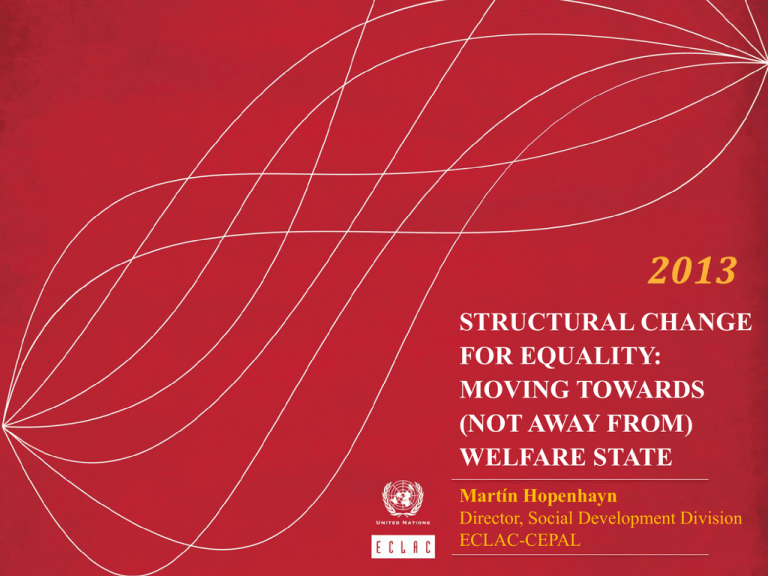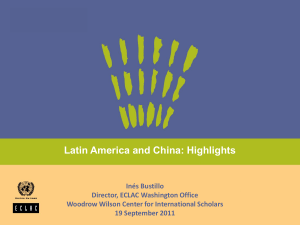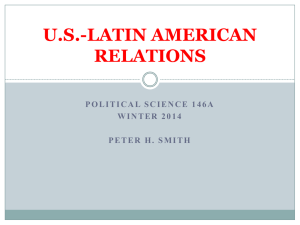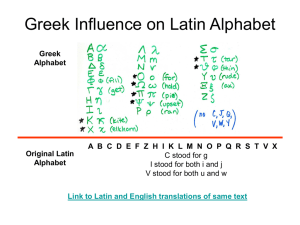
STRUCTURAL CHANGE
FOR EQUALITY:
MOVING TOWARDS
(NOT AWAY FROM)
WELFARE STATE
Martín Hopenhayn
Director, Social Development Division
ECLAC-CEPAL
I. Equality and structural change:
the horizon for rethinking
development in Latin America
Why time for equality?
•
•
•
The financial crisis questions the dominant model, opening an opportunity to chart a new
course regarding the role of the State. Ironically, castling tendencies comparing Europe and
Latin America.
In LA, that model had been associated with two decades of high wealth concentration and
failures in terms of growth, investment, productivity and labor markets. This balance puts us
on the way to (not on the way back), progressive forms of Welfare State seeking sinergies
between social networks, capacity development, increase in productivity with changing
productive patterns.
Regarding equality, this means, for the region, facing up to its historical and more recent
liabilities:
– Worst income distribution in the world
– Increasingly heterogeneous production patterns
– Reproduction of gaps through educational attainments and capacity-development
– Segmentation of the labour market and social protection
– Racial, ethnic and gender discrimination
Equality requires
Closing economic and social gaps, both internal and external
Changes in the economic structure and the social fabric:
• Development of productive and technological capabilities
• Opportunities for full employment
• Universal access to social protection
• Welfare State for a workfare society?
Strengthening the role of the State (as a guarantor of rights
and a driver of policies) for sustainable economic and social
development
II. Good news in general
development indicators, but gaps
in equality and in productivity are
main challenges for the future
Latin America and the Caribbean is forecast to
grow at 4% in 2013
LATIN AMERICA AND THE CARIBBEAN: GDP GROWTH RATES, 2013
(In percentages)
Haiti
Panama
Peru
Paraguay
Nicaragua
Chile
Dominican Republic
Equador
Colombia
Bolivia (Plur. St. of)
Latin America & the Caribbean
Uruguay
Mexico
Costa Rica
Brazil
Guatemala
Argentina
Venezuela (Bol. Rep. of)
Honduras
Cuba
The Caribbean
El Salvador
Source: Economic Commission for Latin
America and the Caribbean (ECLAC).
7.5
7.0
5.5
5.0
5.0
4.8
4.5
4.5
4.5
4.5
4.0
4.0
4.0
4.0
4.0
3.5
3.5
3.0
3.0
3.0
2.2
2.0
0.0
2.0
4.0
6.0
8.0
Latin America: varying fiscal spaces, but
greater than those of OECD countries
LATIN AMERICA AND OECD: OVERALL FISCAL BALANCE AND PUBLIC DEBT, 2011
(Percentage of GDP)
Source: Economic Commission for Latin America and the Caribbean (ECLAC), on the basis of official figures.
Poverty and extreme poverty continue to fall
during 2011
LATIN AMERICA; EVOLUTION OF POVERTY AND EXTREME POVERTY, 1980-2012
(Percentages and millions of persons)
60
250
48,4
43,8
43,9
204
Porcentajes
40,5
40
32,8
31,0
29,4
28,8
30
22.6
20
18.6
18.6
19.3
13.0
12.1
11.5
11.4
Millones de personas
50
215
225
200
150
184
176
168
167
136
95
100
91
99
62
73
69
66
66
2009
2010
2011
2012
50
10
0
0
1980
1990
1999
Indigentes
2002
2009
2010
2011
2012
Pobres no indigentes
Source: ECLAC, special tabulations of household surveys of respective countries.
a Estimaction for 18 LA countries plus Haiti..
1980
1990
1999
2002
Pobres no indigentes
Indigentes
Advances in income distribution …
LATIN AMERICA: GINI COEFFICIENT, 2002 and 2011
0.65
RD
2011
0.55
PYCO HN
CL PA
CR
MX
PE
ECSV
0.45
UY
0.35
0.35
AR
NI
BR
BO
VE
0.45
0.55
2002
0.65
But Latin America and the Caribbean is still
the most unequal region in the world
LATIN AMERICA AND THE CARIBBEAN AND OTHER REGIONS OF THE WORLD: GINI COEFFICIENT, AROUND 2009 a
(Millions of persons)
Source: ECLAC, on the basis of special tabulations of data from household surveys conducted in the respective countries; World Bank, World Development Indicators [online]
http://databank.worldbank.orgddp/home.do.
a The regional data are expressed as simple averages, calculated using the latest observation available in each country for the 2000-2009 period.
b Organization for Economic Cooperation and Development.
Taxes and transfers do not offset inequality in the
region in a significant way
LATIN AMERICA AND OECD: GINI COEFFICIENT BEFORE AND AFTER TAXES AND TRANSFERS
Source: CEPALSTAT for countries of Latin America and OCDEStat for the OECD countries.
CONCLUDING SECONDARY EDUCATION: WHERE THE
GREAT GAP BEGINS
LATIN AMERICA (18 COUNTRIES): POPULATION AGED 20-24 WITH COMPLETE SECONDARY EDUCATION BY PER
CAPITA
INCOME AND SEX, AROUND 2008
(Percentages)
Source: Economic Commission for Latin America and the Caribbean (ECLAC), on the basis of special tabulations of data
from household surveys conducted in the respective countries.
a The data for indigenous and non-indigenous young people refer to eight countries and correspond to 2007.
Skills: the link education - employment reproduces
and eventually expands social inequalities
and poverty
LATIN AMERICA (18 COUNTRIES): MONTHLY LABOUR INCOME OF THE EMPLOYED POPULATION, BY AGE GROUP AND LEVEL OF SCHOOLING
(Dollars at 2000 prices, PPP)
Source: Economic Commission for Latin America and the Caribbean (ECLAC), on the basis of special tabulations of household surveys in the respective
countries , around 2008).
Productive structure and employment:
employment is concentrated in low-productivity
sectors
LATIN AMERICA (18 COUNTRIES): STRUCTURAL HETEROGENEITY INDICATORS, AROUND 2009
(Percentages)
Source: Economic Commission for Latin America and the Caribbean (ECLAC), on the basis of R. Infante, “América Latina en el ‘umbral del desarrollo’. Un
ejercicio de convergencia productiva”, Working Paper, No. 14, Santiago, Chile, June 2011, unpublished.
Although unemployment rates have fallen, lack of
social security and low productivity are strong
barriers in closing income distribution gaps
LATIN AMERICA (14 COUNTRIES): POPULATION LIVING IN HOUSEHOLDS WITHOUT SOCIAL SECURITY MEMBERSHIP AND WHICH DO NOT
RECEIVE ANY PENSION OR PUBLIC WELFARE TRANSFERS, BY INCOME QUINTILE, 2009
(Percentages)
Source: Economic Commission for Latin America and the Caribbean (ECLAC), on the basis of special tabulations of data from household surveys conducted in the respective countries.
A pro-equality State: strategies
and policies
In the social sphere: redistributive policies and
capability-building
• Redistributive policies
– Social protection systems aimed at universal coverage
– Strengthening the non-contributory pillar of social
protection
– Ensure that fiscal policy has a progressive impact on income
distribution
• Training and capability-building
– Rethinking and redesigning education and training systems
and ways to disseminate use of ICT
– Training for the job market: ongoing acquisition of new skills
and knowledge through training and on-the-job learning.
Social sphere trascends social policies: challenges of a
new role for the State in terms of structural
(productive) convergence, key of social inclusion
• Linking low-productivity sectors with a mainstream inducted structural
change. Who will promote it, if not the State?
• An integrated strategy for reducing structural heterogeneity: inclusive
financing, support for SMEs, including linking them with more dynamic
sectors, capacity development, transitional protection networks.
• Labor institutions allowing covenants among actors (State, work unions,
entrepreneurs), aiming to reduce income gaps, build trust, promote
motivation and sense of belonging, move towards a more fair
appropriation of upscaling productivity.
• Role of State in care economics in order to move towards national systems
of care: positive impact on expanding participation in labor market, mainly
women from low-income strata; positive impact in work distribution
between men and women.
• Fiscal covenant to promote structural change for equality.
A fiscal covenant means that the different public
and private stakeholders must come together to
define priorities and instruments
•
•
•
•
A clear-cut path for the State to:
– Gradually increase the tax burden, with a view to creating tax systems providing
appropriate incentives for productive investment
– Reform the tax structure by previously agreed stages, primarily by raising income tax
– Improve tax collection by reducing and progressively controlling tax evasion, and
gradually eliminating exemptions from direct taxes with a view to achieving greater
equity and efficiency
A shared platform which correlates changes in the tax burden and structure with the
allocation of the generated fiscal space among public policies
A clear, agreed public agenda for enhancing the transparency, efficiency and
effectiveness of public spending and institutions
A roadmap for gradually reprogramming social spending in which intra- and intersectoral
restructuring demonstrably produces a stronger redistributive impact, greater social
cohesion and more widespread externalities in terms of equity and productivity
Protecting vulnerable sectors during the initial
phases of structural change
• Virtuous structural change improves income distribution over the
long run by creating jobs in high-productivity activities
• However, changes in the demand for labor may temporarily
increase labor-market segmentation
• Social safety nets must therefore be broadened by means of:
– Non-contributory transfers
– Minimum wage policy
– Training, unemployment insurance, among others
Welfare gaps in Latin America imply different
departing thresholds and progression paths
AMÉRICA LATINA (GRUPOS DE PAÍSES): INDICADORES SELECCIONADOS DE BIENESTAR a
Grupo III
Grupo I
Grupo II
Argentina, Brasil,
Chile, Costa Rica,
Panamá, Uruguay
Colombia, México,
Venezuela
(República
Bolivariana de)
6 601
5 320
1 975
4 074
52,9
54,8
68,3
60,9
19,7
35,1
52,1
38,4
6,7
14,7
26,8
18,1
Ocupados en el sector informal alrededor de
2008 (en porcentajesdel total de ocupados)
41,6
55,3
65,3
55,7
Carga tributaria incluyendo contribuciones
sociales, 2007/2008 (porcentajesdel PIB) c
24,8
13,7
16,4
1 209
619
181
597
18,6
11,8
10,2
13,3
64,4
26,6
14,1
33,0
23,3
35,1
72,1
49,7
PIB per cápita 2008 (dólares de 2000)
Tasa de dependencia demográfica 2005/2010 b
Población pobre alrededor de 2008 (en porcentajes)
Población indigente alrededor de 2008 (en porcentajes)
Gasto público social per c ápita 2007/2008
(dólares de 2000)
Gasto público social 2007/2008 (porcentajesdel PIB)
Cobertura de pensiones a jubilados (en porcentajes).
Áreas urbanas
Porc entaje que declara gasto de bolsillo para
atención de salud
a
Bolivia (Estado Plurinacional
de), Ecuador, El Salvador,
Guatemala, Honduras,
Nicaragua, Paraguay, Perú,
República Dominicana
Prom edio s si mple s d e los países.
b
La relación de dependencia equivale a la población de 0 a 14 años más la población de 65 años y más sobre la población de 15 a 65 años multiplicado por 100.
c
En Arg entina , e l Estado Plur inac io nal d e Bo livia, el Bra sil, Ch ile y Co sta Ri ca las c ifr as c orre sp ond en a l g obi erno gen eral ; en los demás c asos refie ren al go bie rno c en tral.
América Latina
18,7










